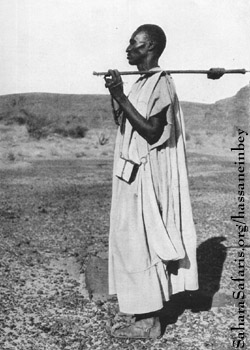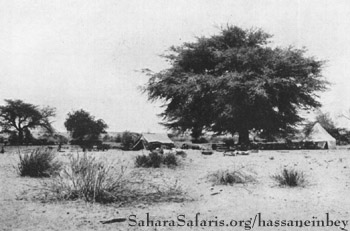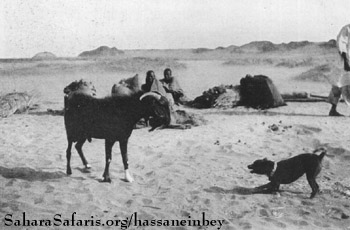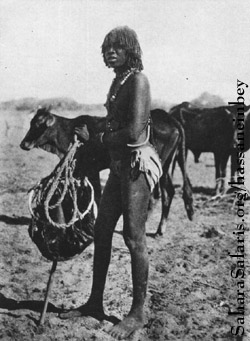GRUELING MARCH UNDER TEMPERATURE EXTREMES
From the standpoint of temperature, the march
south from Kufra was the worst stretch of the entire journey, for it was
too hot for travel in the middle of the day and too cold a night. We
finally found it necessary to break the trek into two parts, starting
long before dawn (2 and 2:30 o'clock) and continuing until 9; then
resting until 3:45 or 4 in the afternoon and trekking until 8:30 in the
evening. For eight days we had only four hours of comfortable sleep in
24.
Finally, one morning just before dawn, after
laboring wearily over a series of steep sand dunes, suddenly there
loomed up in the distance a range of mountains resembling hoary medieval
castles, half hidden in the mist. A few moments later the sun peered
above the horizon and flooded these distant gray walls with warm rose
and pink (see page 255).
I allowed the caravan to go on without me, and for
half an hour I remained seated upon a dune gazing at those
hitherto-legendary mountains. For whatever sacrifices I had made and
hardships I had endured, there was full compensation in those few
moments, as I realized that I had found what I came to seek. Behind
those hills lay the valleys of the first of the two lost oases—Arkenu.
The Arkenu range is a series of conical masses
rising abruptly from the floor of the desert and sheltering a fertile
valley (see page 255).
The oasis has no permanent village, nor is it
inhabited throughout the year, but black Bedouins, Tebus, and members of
the Goran tribe take camels there during the grazing season. Sometimes,
after
(p270) driving their herds
into the valley, the owners close the narrow entrance with rocks and
leave the animals for three months, at the end of which time they are in
wonderful condition.
(p271) [photo]
(p272)

A BIDIAT
CHIEF
His sword, over his shoulder, is carried
ordinarily on the left arm, with his wrist through the thong. [photo
page 271]

APPROACHING
THE SUDAN
The camp at Bao, on the frontier between
the French Sudan and the Anglo-Egyptian Sudan. [photo page 272]

BIBO HAS AN
ARGUMENT WITH A GIFT GOAT
A friendly chief had presented the goat
to the caravan as a symbol of hospitality. [photo page 272]

A SUDAN GIRL
WITH A HIDE BUCKET
She is wearing a handsome amber
necklace, which she refused to sell, even though the author offered gold
for it. Amber ornaments are supposed to have found their way into the
Sudan from Germany. [photo page 273]
The mountain chain of Arkenu runs for something
less than 10 miles from north to south and perhaps 12½ miles from east
to west, but I had no opportunity to explore it fully in the latter
direction.
The principal interest in this oasis lies in the
possibility it affords for exploring the southwest corner of Egypt,
which up to present has not been penetrated either by military parties
or by travelers. No one had known up to this time of the existence of a
dependable water supply in this part of the desert.
Arkenu may conceivably have strategic value at some
future date, for it stands at the meeting point of the western and
southern boundaries of Egypt
(see map, page 236).
 
|
